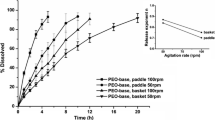Abstract
In this work, the dissolution behaviors of a series of sodium alkylbenzenesulfonates (NaLAS) tablets with different moisture contents and neutralization degrees were investigated in aqueous solution. The ANOVA-based, model-independent and model-dependent methods were employed to perform comparison analyses on dissolution profiles. The measurements of powder X-ray diffraction patterns and mechanical properties elucidate distinct differences in each formula. The results show that ANOVA provides a possibility for finding the source of differences among different variables, and the model-independent methods including the k values and mean dissolution time are easy to interpret and perform comparison analyses. The Hixson–Crowell model gives satisfactory correlation results for the dissolution data and the dissolution kinetics parameters are obtained. The inhibition effects of neutralization degree and moisture content on NaLAS dissolution were examined, which reveals that the increase in lamellar phase proportion leads to the reduction of dissolution rate. The comparison analyses performed in this work form part of a methodology for dissolution profile prediction and comparison.









Similar content being viewed by others
References
Miller CA. Dissolution rates of surfactants. Adv Polym Sci. 2008;218:3–24.
Oliver-Rodríguez B, Zafra-Gómez A, Reis MS, Duarte BPM, Verge C, de Ferrer JA, Pérez-Pascual M, Vílchez JL. Evaluation of linear alkylbenzene sulfonate (LAS) behaviour in agricultural soil through laboratory continuous studies. Chemosphere. 2015;131:1–8.
Holmberg K, Bo J, Kronberg B, Lindman B. Surfactants and polymers in aqueous solution. 2nd ed. Chichester: Wiley; 2003.
Scheibel JJ. The evolution of anionic surfactant technology to meet the requirements of the laundry detergent industry. J Surfactants Deterg. 2004;7(4):319–28.
Yu Y, Zhao J, Bayly AE. Development of surfactants and builders in detergent formulations. Chin J Chem Eng. 2008;16(4):517–27.
Sanderson H, Dyer SD, Price BB, Nielsen AM, van Compernolle R, Selby M, Stanton K, Evans A, Ciarlo M, Sedlak R. Occurrence and weight-of-evidence risk assessment of alkyl sulfates, alkyl ethoxysulfates, and linear alkylbenzene sulfonates (LAS) in river water and sediments. Sci Total Environ. 2006;368(2):695–712.
Appel PW. Modern methods of detergent manufacture. J Surfactants Deterg. 2000;3(3):395–405.
Walsh JM, Tiddy GJT. Liquid crystal phase behavior of branched poly(oxyethylene) surfactants. Langmuir. 2003;19(14):5586–94.
Stewart JA, Saiani A, Bayly A, Tiddy GJT. The phase behaviour of lyotropic liquid crystals in linear alkylbenzene sulphonate (LAS) systems. Colloids Surf A. 2009;338(1):155–61.
Richards C, Tiddy GJT, Casey S. Lateral phase separation gives multiple lamellar phases in a “binary” surfactant/water system: the phase behavior of sodium alkyl benzene sulfonate/water mixtures. Langmuir. 2007;23(2):467–74.
Ramaraju SM, Carroll BJ, Chambers JG, Tiddy GJT. The liquid crystalline phases formed by linear-dodecylbenzene sulphonic acid during neutralisation with sodium carbonate. Colloids Surf A. 2006;288(1–3):77–85.
Stewart JA, Saiani A, Bayly A, Tiddy GJT. Phase behavior of lyotropic liquid crystals in linear alkylbenzene sulphonate (LAS) systems in the presence of dilute and concentrated electrolyte. J Disper Sci Technol. 2011;32(12):1700–10.
Richards C, Tiddy GJT, Casey S. Liquid crystal and solution phases of sodium dodecyl-p-benzene sulphonate (NaLAS) and octa-oxyethylene glycol hexadecyl ether (C16E8): 1:1 mixtures in water. Colloid Polym Sci. 2008;286(1):31–46.
Dokoumetzidis A, Macheras P. A century of dissolution research: from Noyes and Whitney to the biopharmaceutics classification system. Int J Pharm. 2006;321(1):1–11.
Ahuja N, Katare OP, Singh B. Studies on dissolution enhancement and mathematical modeling of drug release of a poorly water-soluble drug using water-soluble carriers. Eur J Pharm Biopharm. 2007;65(1):26–38.
Heng D, Cutler DJ, Chan HK, Yun J, Raper JA. Dissolution kinetic behavior of drug nanoparticles and their conformity to the diffusion model. Langmuir. 2008;24(14):7538–44.
Yuksel N, Kanık AE, Baykara T. Comparison of in vitro dissolution profiles by ANOVA-based, model-dependent and-independent methods. Int J Pharm. 2000;209(1):57–67.
Anderson N, Bauer M, Boussac N, Khan-Malek R, Munden P, Sardaro M. An evaluation of fit factors and dissolution efficiency for the comparison of in vitro dissolution profiles. J Pharm Biomed Anal. 1998;17(4):811–22.
Polli JE, Rekhi GS, Augsburger LL, Shah VP. Methods to compare dissolution profiles and a rationale for wide dissolution specifications for metoprolol tartrate tablets. J Pharm Sci. 1997;86(6):690–700.
Costa P, Lobo JMS. Modeling and comparison of dissolution profiles. Eur J Pharm Sci. 2001;13(2):123–33.
Hixson AW, Crowell JH. Dependence of reaction velocity upon surface and agitation. Ind Eng Chem. 1931;23(10):1160–8.
Rinaki E, Dokoumetzidis A, Macheras P. The mean dissolution time depends on the dose/solubility ratio. Pharm Res. 2003;20(3):406–8.
Noyes AA, Whitney WR. The rate of solution of solid substances in their own solutions. J Am Chem Soc. 1897;19(12):930–4.
Dokoumetzidis A, Papadopoulou V, Macheras P. Analysis of dissolution data using modified versions of Noyes–Whitney equation and the Weibull function. Pharm Res. 2006;23(2):256–61.
Fagerberg JH, Tsinman O, Sun N, Tsinman K, Avdeef A, Bergström CAS. Dissolution rate and apparent solubility of poorly soluble drugs in biorelevant dissolution media. Mol Pharm. 2010;7(5):1419–30.
Polli JE, Rekhi GS, Shah VP. Methods to compare dissolution profiles. Drug Inf J. 1996;30(4):1113–20.
Acknowledgements
P&G Technology (Beijing) Co., Ltd. is gratefully acknowledged for kindly providing experimental facilities and financial support.
Author information
Authors and Affiliations
Corresponding author
Electronic supplementary material
Below is the link to the electronic supplementary material.
About this article
Cite this article
Pan, B., Shen, R., Guan, Z. et al. Insights into the Dissolution Kinetics of NaLAS Tablets. J Surfact Deterg 20, 1433–1441 (2017). https://doi.org/10.1007/s11743-017-2017-x
Received:
Accepted:
Published:
Issue Date:
DOI: https://doi.org/10.1007/s11743-017-2017-x




